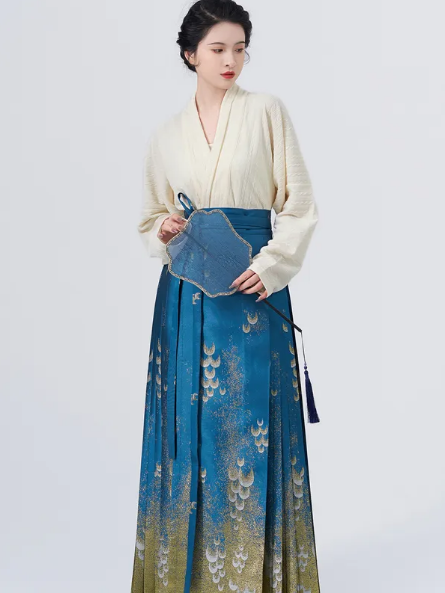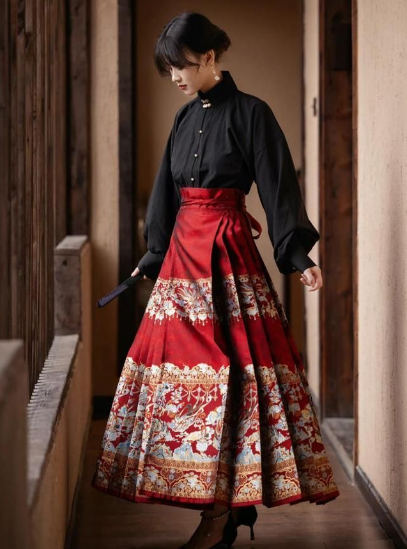Historical Origin
Exploring the deep roots of the Horse-Face Skirt reveals a rich tapestry of Chinese history and tradition.
Development in Ancient China
Originating in the Song Dynasty, the Horse-Face Skirt was more than just attire; it was an embodiment of the era’s aesthetic and societal values. Crafted meticulously to balance practical needs with elegance, these skirts became a symbol of grace and functionality, catering especially to women’s needs during that period.

Evolution Through Dynasties
As centuries passed, the Horse-Face Skirt witnessed transformations through various Chinese dynasties. Each period added its unique flair, altering its style, materials, and cultural relevance. The Ming and Qing dynasties, for instance, introduced more elaborate designs and richer fabrics, reflecting the evolving fashion sensibilities. This evolutionary journey transformed the skirt from a functional garment to a significant cultural icon, showcasing the changing tides of Chinese societal norms and fashion trends.
Throughout its history, the Horse-Face Skirt has remained a testament to the rich cultural heritage of China, adapting and flourishing with each passing era.
Design Structure
Delving into the Horse-Face Skirt’s design reveals a masterful blend of tradition and utility.
Overlapping Panels
Central to its design are the two identical panels that overlap. These panels, forming the skirt’s body, create a unique aesthetic and functional structure. When sewn together at the waistband, they produce an elegant and practical overlap, allowing for ease of movement and a distinct visual appeal.
Wrap-Around Style
Its wrap-around style is both practical and versatile. This skirt wraps securely around the waist, accommodating various body shapes with ease. This method of fastening not only provides a comfortable fit but also enhances the skirt’s flowing and graceful appearance. The wrap-around design stands out for its simplicity and elegance, reflecting the skirt’s traditional roots while offering modern adaptability.
Material and Fabrication
The Horse-Face Skirt stands out for its exquisite material choice and meticulous fabrication process.
Common Fabrics Used
Traditionally, artisans select silk for its luxurious sheen and unrivaled softness, making it a prime choice for high-end skirts. Cotton, valued for its breathability and durability, serves as a more practical option for everyday wear. These fabrics not only lend themselves to the skirt’s beauty but also its functionality, providing comfort and elegance in equal measure.
Techniques in Fabric Handling
Skilled craftsmen employ various techniques to manipulate these fabrics. Precise cutting ensures the panels fit perfectly, while expert sewing techniques guarantee durability. Embroidery, often done by hand, adds intricate details, elevating the skirt from a simple garment to a work of art. This careful attention to detail in every stitch and fold is what sets the Horse-Face Skirt apart in quality and design.
Aesthetic Features
The aesthetic allure of the Horse-Face Skirt lies in its rich array of colors and patterns, each imbued with deep symbolism.
Color and Pattern Variations
Artisans use a spectrum of colors, from deep, majestic reds symbolizing good fortune, to soft, earthy tones reflecting tranquility. Patterns range from simple, understated lines to complex, ornate motifs, each meticulously crafted to portray different aspects of Chinese culture and art. The choice of color and pattern not only enhances the skirt’s visual appeal but also conveys specific cultural or personal sentiments.
Symbolism in Design
The designs often carry profound symbolism, deeply rooted in Chinese philosophy and natural imagery. Floral patterns, for instance, may represent beauty, femininity, and the cycle of life, while dragons and phoenixes symbolize power and auspiciousness. Geometric patterns are not mere decorations; they often represent philosophical ideas like cosmic balance and harmony. This rich symbolism woven into the fabric of the Horse-Face Skirt makes it a garment steeped in cultural significance and artistic expression.
Functional Aspects
The Horse-Face Skirt is not only aesthetically pleasing but also remarkably functional.
Adaptability for Movement
Designed with comfort in mind, its overlapping panels allow for a wide range of movement. This feature, combined with the wrap-around style, ensures the wearer can walk, sit, or engage in more active pursuits with ease. The flexibility inherent in the skirt’s design makes it suitable for various body types and movements.
Suitability for Different Activities
The skirt’s versatility extends to its suitability for different activities. From daily tasks to special events, its design accommodates a range of movements. The skirt’s practicality is evident, whether in a casual setting or during more formal occasions, where ease of movement is essential. It’s this adaptability that has sustained the skirt’s popularity over centuries.
Cultural Significance
The Horse-Face Skirt’s cultural significance spans centuries, deeply embedded in Chinese heritage and influencing modern fashion.

Representation in Chinese Culture
In Chinese culture, this skirt symbolizes traditional grace and femininity. Its intricate designs often incorporate cultural stories and philosophies, making it a wearable piece of history. The skirt’s prominence in traditional festivals and ceremonies underscores its role as a cultural emblem, reflecting the enduring legacy of Chinese textile art.
Influence on Modern Fashion
In the realm of modern fashion, the Horse-Face Skirt has inspired contemporary designers to blend traditional elements with new styles. Its unique aesthetic has been reimagined in modern collections, showcasing its versatility and timeless appeal. This blend of old and new underscores the skirt’s enduring influence on fashion trends, bridging the gap between traditional artistry and contemporary design.







